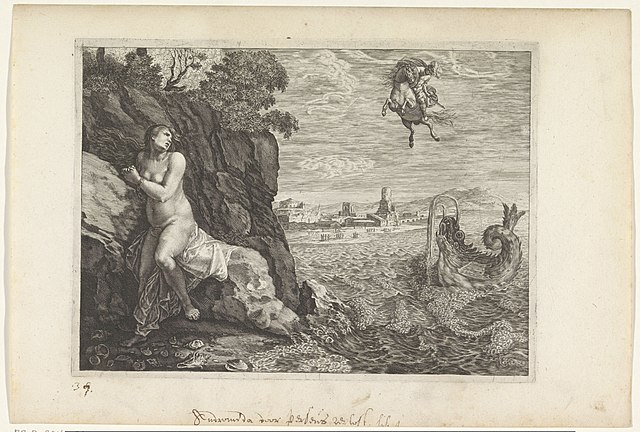As you stand on the upper level of Jaffa’s Old City and look down into the sea, you can spot some black rocks that appear and disappear when the waves wash over them.
 Andromeda's Rock in Jaffa
Andromeda's Rock in Jaffa
One of these is Andromeda Rock, and the group of rocks is also referred to as Andromeda’s Rocks. They get their name from a Greek legend, about a damsel in distress, a sea monster, and a brave hero.
You can see the group of rocks among the waves offshore, at the northern end of the Old Jaffa Port, where the harbor opens up to the sea.
Pro Tip: The best view (and the best place for an Instagramable shot), is from the elevated position high in Jaffa’s Old City. Go to Kedumim Square, or stand on the upper level of HaMidron Park.
In Greek mythology, Andromeda was the beautiful daughter of King Cepheus, the king of Jaffa, and his wife, Queen Cassiopeia. The queen would boast about her daughter’s beauty, saying she was even more beautiful than the mermaids. Well, the mermaids didn’t like this, and they went to Poseidon, king of the sea, to complain. They asked him to put the vain humans in their place and teach them a lesson.
So Poseidon obliged and sent a huge wave of water and a sea monster called Cetus to destroy the city of Jaffa. King Cepheus didn’t know what to do so he consulted the oracle who advised him to sacrifice his daughter Andromeda to the sea monster to appease Poseidon.
 Andromeda waiting for the monster, artwork from 1636
Andromeda waiting for the monster, artwork from 1636
The residents of Jaffa pressured the king to give up his daughter and save the city. Eventually, Cepheus offered up his daughter to the sea monster by chaining her to the rocks just off the shore of Jaffa. She was left there awaiting her fate.
Enter the hero of the story, Perseus, son of Zeus. He was passing through Jaffa and saw Andromeda out at sea chained to the rocks. He fell instantly in love and appealed to the king and queen for her hand in marriage. They said that if he could rescue Andromeda from the sea monster, he could marry her.
Perseus bravely rowed out to the rocks and battled the sea monster. He cut off the monster’s head and it fell into the water, becoming sea rocks. Perseus untied Andromeda, and they returned to Jaffa and lived happily ever after.
Is Andromeda’s Rock Really in Jaffa?
Jaffa is not mentioned in classical literature as the site of Andromeda’s Rock. In fact, the Greek myth is set in the Kingdom of Ethiopia, which was a name used to refer to the region of northeastern Africa. The association with Jaffa happened much more recently. Perhaps the legend of the Andromeda Rocks in Jaffa arose because of Jaffa’s proximity to northeastern Africa. It is also possible that someone thought the rocks off the shore of Jaffa resembled a sea monster’s head. When you look down on the rocks from Jaffa’s Old City they do resemble a dragon (with a bit of imagination)!
 Israeli Sea Scouts rowing past the rocks adjacent to the Jaffa shore
Israeli Sea Scouts rowing past the rocks adjacent to the Jaffa shore
Pro Tip: If you want to know what you are looking for, and exactly where to look, check out “Jaffa Port” on Google Maps and zoom in on the harbor in “Satellite View” mode.
Off the coast of Jaffa, you can see a group of unassuming rocks. But when you know the story behind them, these rocks become a fascinating attraction. The best place to see Andromeda’s Rocks is from Kedumim Square, the Jaffa Port, or the nearby park in Old Jaffa.
The Greek Myth of Andromeda
Cepheus, the king of Jaffa had a daughter, Andromeda who was famed for her beauty. The king’s wife, Queen Cassiopeia boasted that her daughter was more beautiful than the mermaids. This angered the mermaids who appealed to Poseidon to punish the vain humans. Poseidon sent a deluge of water, and a giant sea creature to destroy Palestine and Jaffa.
King Cepheus was distraught. He consulted with advisors and was pressured by his people to sacrifice his daughter to the sea monster, in the hope of appeasing Poseidon. And so the King had his daughter, Andromeda tied to a rock that jutted out of the sea just off the shore of Jaffa. By chance, Perseus, the son of Zeus, was passing through and saw beautiful Andromeda tied to the rocks.
He fell in love at first sight and King Cepheus and his wife offered Perseus Andromeda’s hand in marriage if he could rescue her from the sea creature. Perseus flew down on his winged horse Pegasus and chopped off the monster’s head which fell into the water and became the famous rocks we see today. The rocks became an everlasting symbol of love between Perseus and Andromeda.